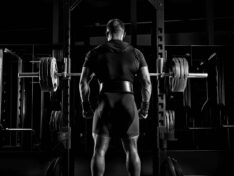What are the Best Exercises for Abs? Try These Simple Routines
Would you like to learn the best ab exercises to lean and tone your midsection? These simple routines will go a long way.

Getting abdominal definition isn't rocket science: you need an ab routine to build a strong core and help define the abdominal muscles.
Unfortunately, it's not going to happen overnight. Everybody dreams of that perfect washboard stomach, not to mention the many massive lifestyle benefits -- such as improved exercise ability (think stronger yoga poses, faster running, and even heavier squats), better posture, and reduced back pain.
I looked at (and tried) many ab routines, and from my research, the approach I'm providing here will give you the best results.
There are several super-effective core-strengthening exercises that are going to help you build ab-definition quickly. And, if you follow the important checks, you'll be able to get the best benefits from each one.
How you choose to incorporate them into your routine is up to you; it could be first thing in the morning, as part of your gym workout, or whenever you have a few minutes to burn (and when I say burn, that's exactly what I mean!)
These are my top ab exercises and routines:
The Best Exercises for Abs
1. Forearm Planks
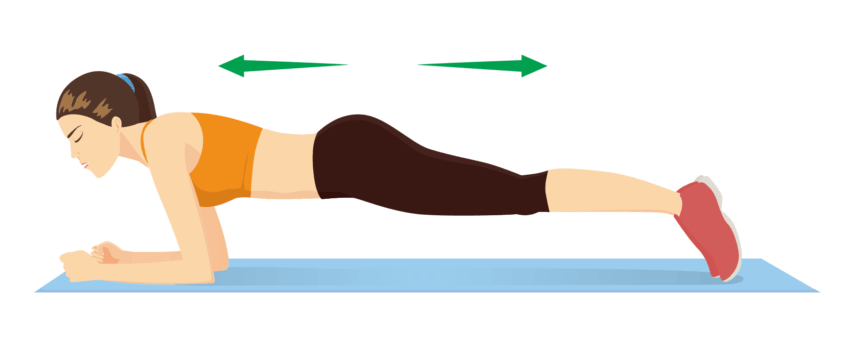
- Start by lying face-down on the ground.
- Get into a forearm plank position with your elbows stacked below your shoulders, hands in fists, and forearms parallel to each other.
- Hold for 20 seconds per set.
Important Checks:
- While breathing deeply, concentrate on squeezing your whole body (from your core to your quads, glutes, and fists).
- Stop if you feel pain in your lower back; you will need to build up the time you spend planking gradually so that your core muscles develop and your back doesn't over-compensate.
2. Dead Bug
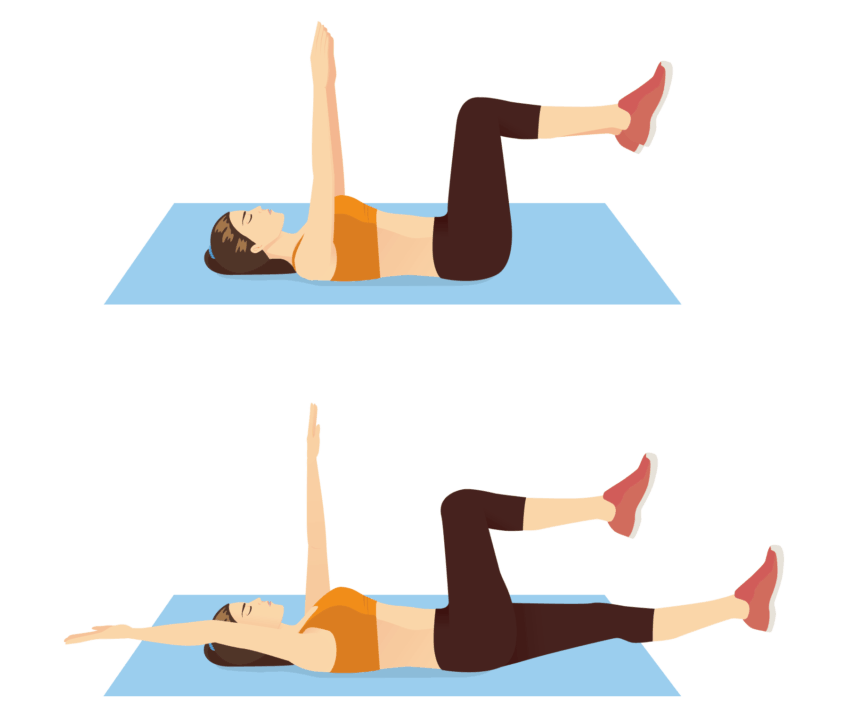
- Lie on your back and position your arms above your shoulders, bring your knees in so they're directly over your hips, and bend your knees so your calf is at a 90-degree angle to your thigh.
- Lower your left arm above your head and, at the same time, straighten your right leg and move it towards the floor.
- Hold for a moment, return to your starting position, and repeat on the other side.
- Complete 7 on each side.
Important Checks
- Keep your lower back flush against the floor.
- Focus on using your breathing to help you complete the reps.
3. Leg Raises
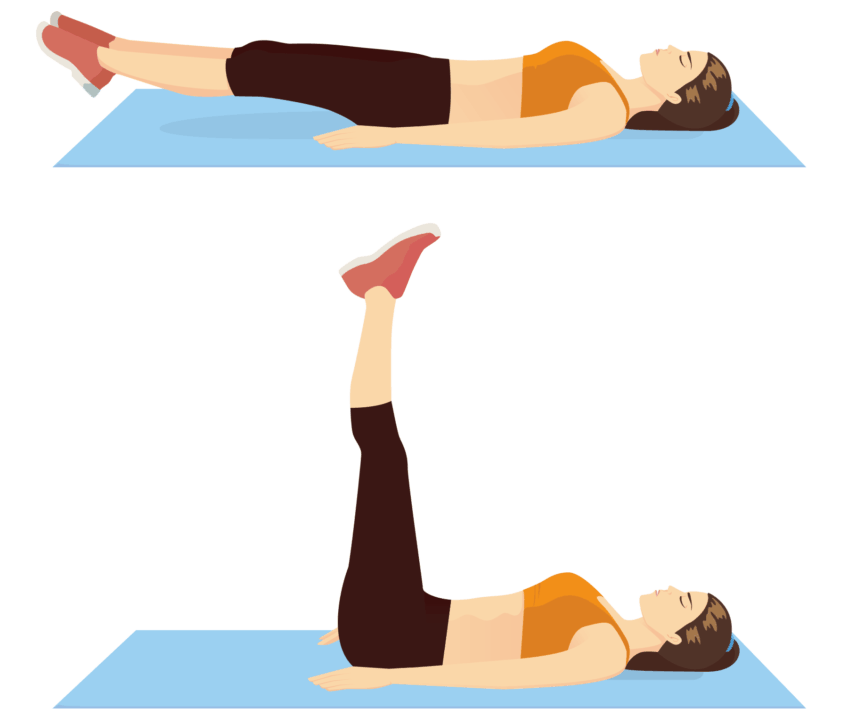
- Start by lying flat on your back with your legs extended in front of you, and place your hands at your sides on the floor for support.
- Engage your lower abdominals, and raise your legs until they make a 90-degree angle with the floor.
- Keeping your abs tight, slowly lower your legs back toward the floor
Important checks:
- Keep your movement slow and deliberate, especially as you lower your legs to the floor, where it can be tempting to drop them down.
- Don't let your back arch too much, which means your back is overcompensating for your abs.
4. Jackknife Sit-Ups
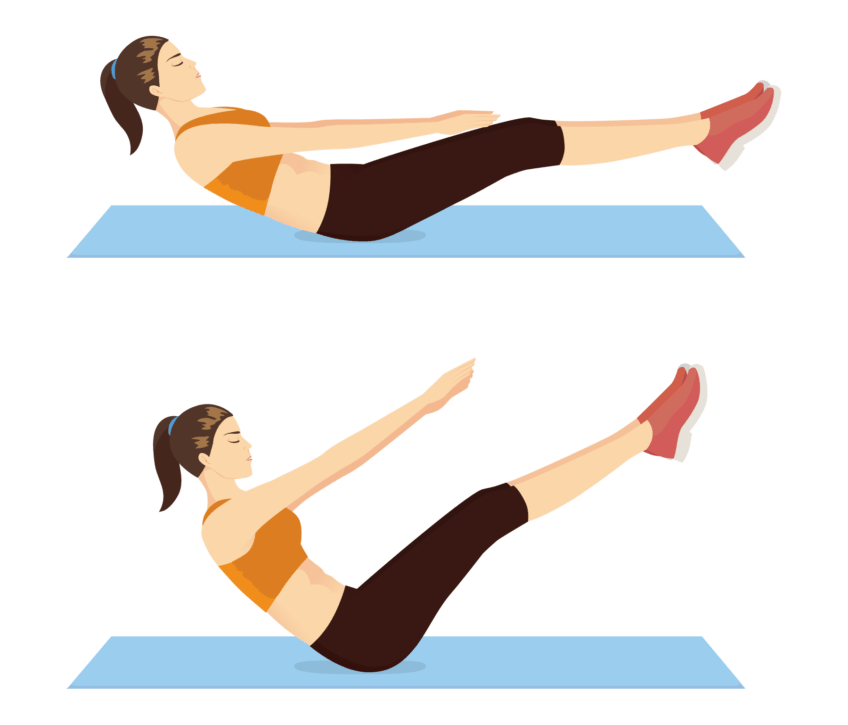
- Lie on your back with your legs extended, and fully extend your arms behind you.
- Engage your lower abs, and raise your legs and arms simultaneously.
- Hold the tension in your abs as you slowly lower your legs and arms back down.
- Repeat 10 times.
Important checks:
- If your back is hurting, stop immediately.
- Stop if you can't maintain form or your lower back is lifting off the ground.
- Don't allow your legs to fall back down; they should be slowly and carefully lowered.
5. Crunches

- Lie on your back with your knees bent, feet on the floor, and hands across your chest.
- Engage your core muscles and use your abs to roll your head, neck, and shoulder blades off the floor.
- Pause as you reach the top of the movement, then slowly lower back down, keeping tension in your abs.
- Repeat 15 – 20 times.
Important Checks:
- Keep your neck untucked while you're crunching.
- Keep your lower back on the floor.
- Ensure that you're in full control throughout, with no rocking.
6. Bird Dog
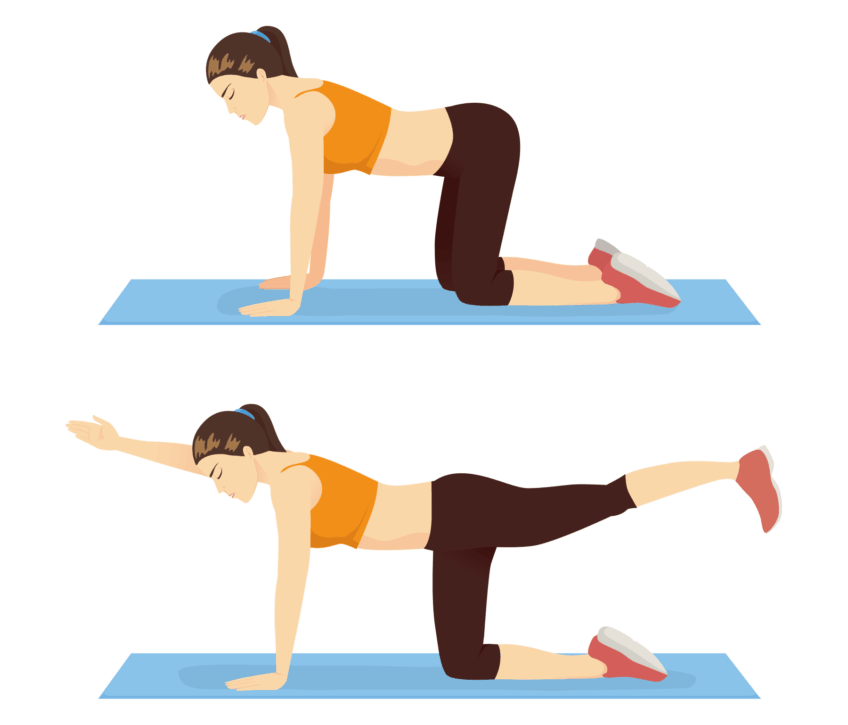
- Start in a tabletop position with your knees under your hips and your wrists under your shoulders.
- Create tension in your core, then lift your right arm and left leg simultaneously, and keep your foot flexed and your palm facing inward.
- Pause for a second as your arm and leg align with your torso, then bring your right elbow towards your left knee under the body.
- Repeat on the other side.
- 5 reps on either side make up 1 set.
Important Checks:
- Don't hyperextend your elbows; a slight bend is going to give your arms more of a challenge.
- Lengthen your neck by keeping your gaze down and slightly in front of you.
- As you exhale, consciously engage your core muscles to improve the efficacy of the movement.
The Ultimate Ab Exercise Routine
If you want results and you want them fast, you need to be doing these routines below every week. If you are unfit or have a weak core, start slowly and build up. It's easy to hurt yourself by overdoing the exercises up-front, which is only going to end badly as you are too sore to continue, and by the time you're healed, you'll be too demotivated to start again.
If you're new to ab exercises, you probably want to choose 3 or so exercises and complete two sets of each (and take a minute's rest between each set).
As your endurance builds up, you can add more exercises, increase the number of sets you're doing, and reduce your rest time. You'll be amazed at how fast you can progress if you take it slow at the start. It's completely doable to start slow, and within 9-12 weeks, you'll probably be able to complete three sets of the seven exercises in one session with a minute of rest in between each set.
Advanced Ab Workout, 3 - 5 times per week:
- #1 and # 2, rest for 30 seconds
- #3 and #4, rest for 30 seconds
- #5 and #6, rest for 30 seconds
- #7, rest for 30 seconds
Repeat x 3
Beginner Ab Workout, 2 - 3 times per week:
- #1, rest for a minute
- #5, rest for a minute
- #7, rest for a minute
Repeat x 2
Personalizing the Workout for Your Needs
If you need to take the intensity down a level as you build fitness, or if you have lower back injuries, substitute exercises can give close to the same benefits without putting strain on your back.
On the other hand, maybe you've been doing ab exercises for a while and have no back issues. Then, you'll probably want to add some extra resistance, which might mean doing more advanced versions of the exercises or using dumbbells.
When should you be working your abs?
You want to include a mix of different ab exercises that will work the lower and upper ab muscles. It's ideal if you can complete the full workout 3 times a week, and you'll get the best results if you combine the workouts with a healthy diet, some cardio, and strength training that targets other areas of the body. As your strength builds up, you could increase the number of days to five or six.
I'm a realist, so while doing all your reps in one session makes sense, I think that something is better than nothing. So, if I only have a few minutes in the morning, I'd rather do one set of exercises, and then if I have time to do more later in the day. Then that's just a bonus.
Of course, it often gets to dinner time, and I haven't done any, which is when I'll put dinner on to cook, turn up the music, and see how many sets I can do before it's time to eat.
Other Benefits of Strong Abs
Most of us start an ab routine because we want to shed a few pounds around our waists (and build some definition), or is it only me?
Luckily, an intensive ab workout's benefits go beyond just the aesthetic benefits.
If you can stick to an ab exercise routine, you're going to enjoy the benefits in your everyday life, including:
- Posture. It's a given that we spend too much time sitting (often slouching) in front of screens, whether it's a computer, mobile phone, or TV. This all puts a huge amount of strain on your spine as the pelvis tilts forward, exaggerating the spinal curve and compressing the vertebrae. Core strength through stronger abdominal walls will help redistribute weight more evenly, opening the hip flexors and strengthening the lower back. We're also prone to hunch over when we walk when the focus should be on a neutral hip position, with a slight curve in the lower back. This happens much more naturally when you have a stronger core.
- Lower back pain. Exercising your abs means that you will also develop mobility and strength in the surrounding muscles, including your back, glutes, thighs, and hips. So, it's a two-fold benefit; you'll be able to recover from backache and protect your back against future injuries. As you become better at engaging your core muscles, you'll also become better at protecting your back (and engaging your core) when you lift heavy things, sit at a desk, or even vacuum.
- Exercise performance. Whatever physical exercise you do, whether football or weightlifting, requires force. To produce this force without injuring yourself, your spine needs to be neutral, which requires a stable core. Building strong abs and an engaged core will improve your performance and keep you fit, healthy, and injury-free.
- Easy breathing. As you train your core, you're also training your breath. Your diaphragm and intercostal muscles, which do all the heavy lifting when it comes to breathing, will contribute to core strength. At the same time, as your core strengthens, it's going to be easier to breathe better as your body is aligned better with your organs and diaphragm correctly positioned.
Conclusion
What I've found works well for me is to separate my core strength exercises from other sessions. Most of them don't need any equipment, so you can get through most of them if you've got 15 minutes to kill.
Then, when I go for a run or hit the gym, I don't need to spend time on ab work. It also means that I'm a bit more consistent; 15 minutes isn't a lot to squeeze into a lunch break or in the early evening while you're waiting for dinner to cook.
Or make yourself a simple rule: before watching any Netflix, knock out at least 3 of the ab exercises I mentioned above.
Getting results quickly is possible if you're prepared to stick to a routine. I've noticed small muscle gains in just a week or two and improved definition after a month of moderate-intensity ab exercises.
While you'll not get a six-pack overnight, or maybe even at all, depending on your body type, you'll definitely notice the improvements visually and physically.
We all enjoy the toning improvements, but the physical improvements – including posture and reduced back pain -will keep you motivated and committed to sticking to your ab workouts.
The most important thing (and I've learned this the hard way) is that you really want to take it slow at the start, then build up consistently. We live in such a fast-paced society that we're always conditioned to want immediate results (with as little effort as possible).
But (and repeat after me), there's no rush! You've got plenty of time to get into shape (after all, how many years have you spent not exercising your core).
A slow and steady approach means that:
- You're going to be more interested in getting your form right, which will dramatically reduce your chances of a back injury,
- You'll ensure that you're getting the best results from each exercise that you do, and
- You'll be more likely to stick to the routine, giving you the best benefits in the long run.
All you need is about 2-3 sessions/week to get killer abs -- with each session only lasting about 15 minutes.
And it should go without saying that your diet must be healthy. Abs are primarily made in the kitchen!
Jessie Clayton
Jessie Clayton is a highly regarded yoga instructor (RYT 500) and certified nutritionist dedicated to guiding individuals on their journey to holistic well-being, with over 5 years of experience in yoga and nutrition. Jessie is an avid Christ follower and passionate advocate for the harmonious integration of mind, body, and spirit.














